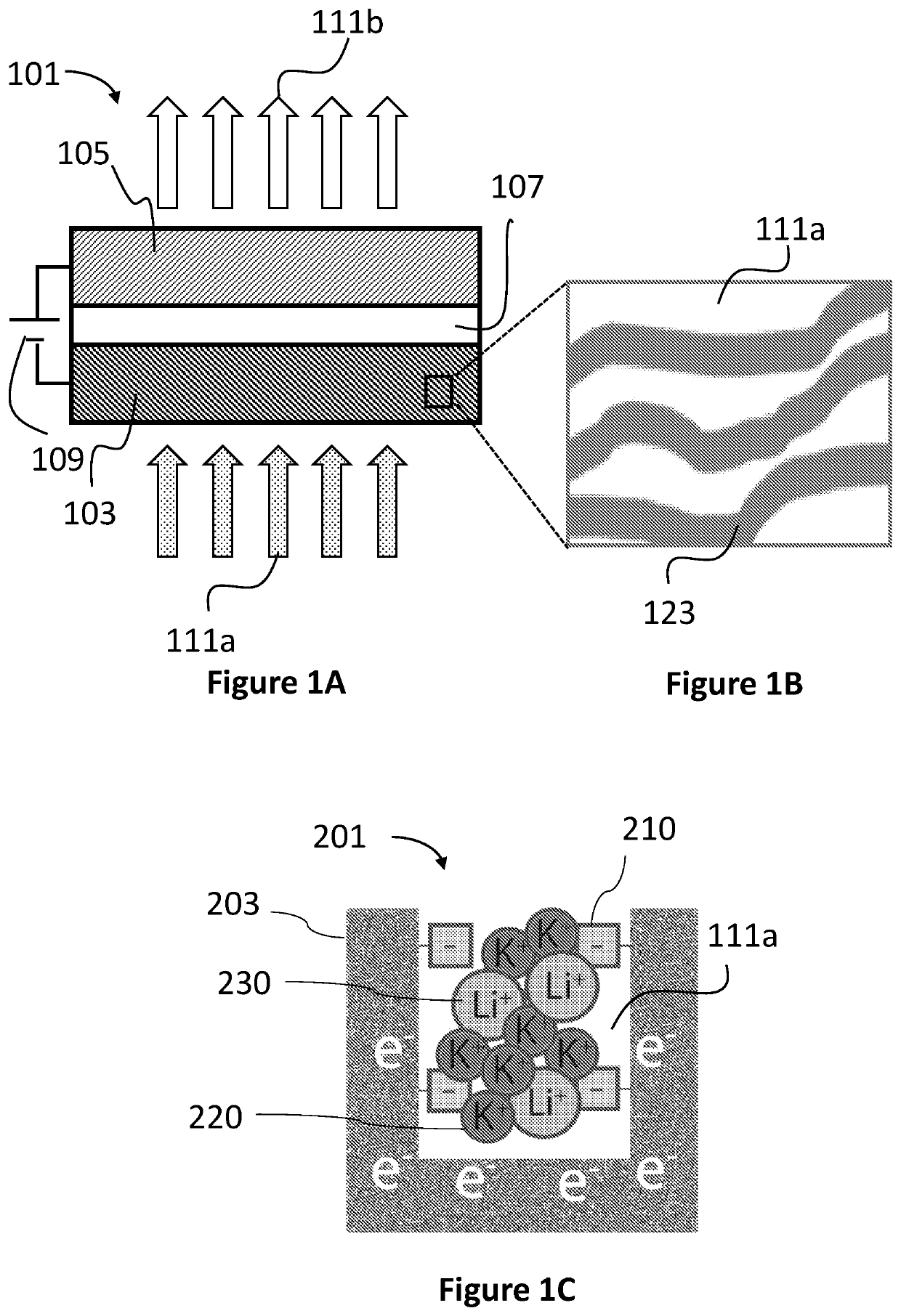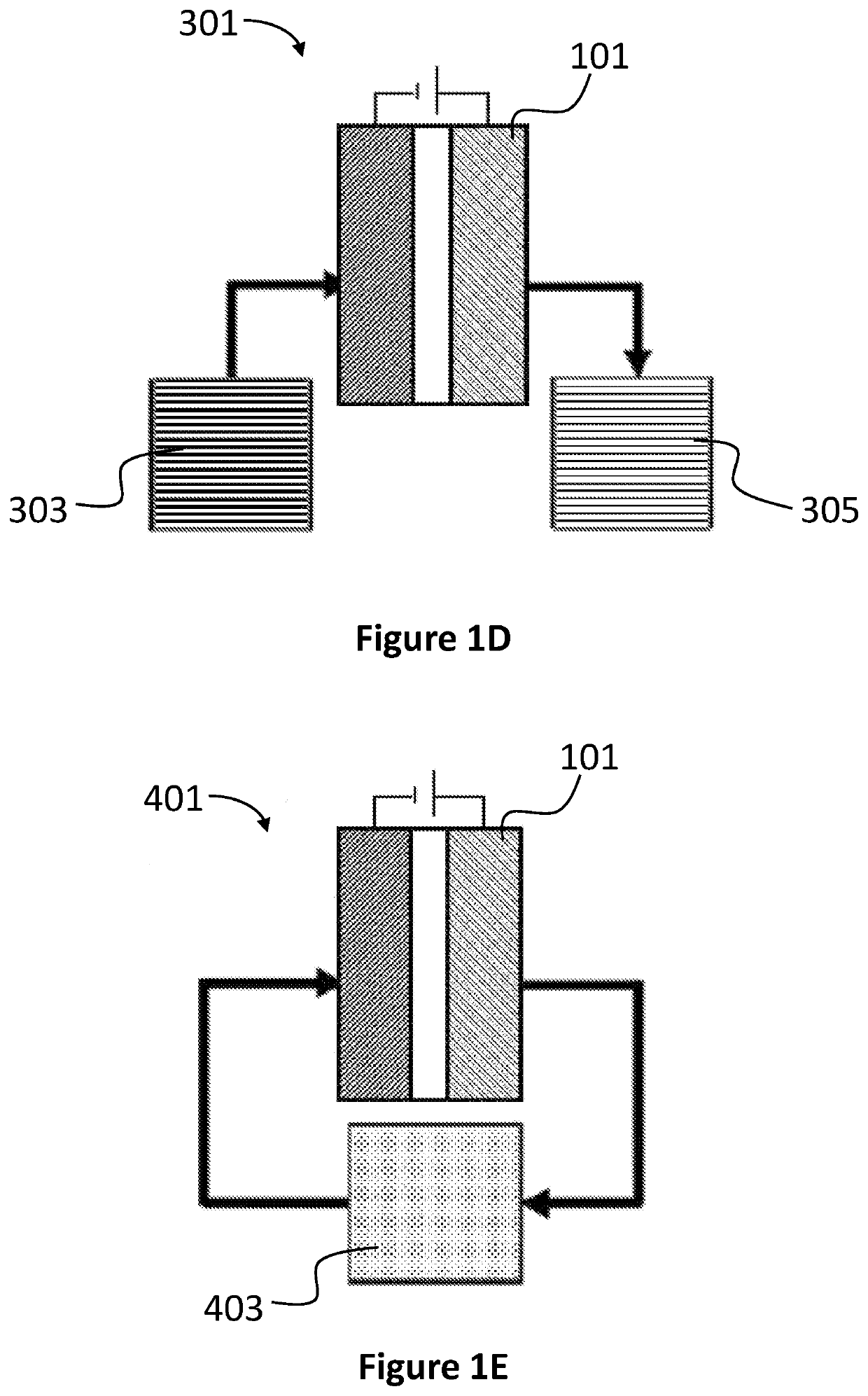Method for selective separation of ionic species from ionic solution based on ionic hydrated size
a technology of ionic species and ionic solution, which is applied in the direction of dispersed particle separation, water/sewage treatment, water/sludge/sewage treatment, etc., can solve the problems of impaired ion selectivity separation, low negative chemical surface charge of oxidized cathode, and difficulty in operation of electrode capacitor assembly, etc., to enhance specific adsorption of ionic species, enhance specific adsorption, and reduce the size of ionic hydrated
- Summary
- Abstract
- Description
- Claims
- Application Information
AI Technical Summary
Benefits of technology
Problems solved by technology
Method used
Image
Examples
example 1
Electrode Preparation
[0162]The electrodes were composed of squares of an activated carbon cloth (ACC-5092-15, Kynol Europa GmbH). Each cloth had a thickness of about 500 μm, and a surface area of 1500 m2 / g (via BET analysis).
[0163]For the anode, the electrode material was used as-received from the manufacturer without any chemical pre-treatment. Throughout the examples, such anode is referred to as “pristine”.
[0164]As for the cathode, the electrode material was subjected to an oxidation treatment. Throughout the examples, such cathode is referred to as “oxidized”. The electrode was immersed in 70 wt % nitric acid for 24 hours, and then then washed in 0.1 M sodium bicarbonate until the surface pH reached approximately 6 (measured with qualitative pH strips). The electrode was then washed with deionized water until the surface pH reaches 7, and dried in air at 80° C. overnight in a circulating oven.
[0165]The total pore volume for both the anode (termed herein “pristine”) and the catho...
example 2
Surface Charge of the Oxidized Electrode
[0166]The surface charge of pristine electrode and the oxidized electrode was determined via pH titration. The electrodes were ground in a mortar and pestle, then added to a vessel containing 0.05 M HCl (7.6 mL for pristine electrode, 0.5 mL for oxidized electrode), 0.05 M NaOH (19.35 mL), and deionized water (62 mL). The solution was nitrogen-sparged, sealed, and then stored for 5 days under stirring. The solution was then transferred to a titration system (Titrando 904 and iAquatrode Plus Pt1000, Metrohm AG, Herisau, Switzerland) and titrated utilizing 0.05 M HCl under a nitrogen atmosphere.
[0167]The results were compared to a control titration sample, which did not contain any electrode material and only contained the same acid and base solutions at the same concentrations as the other samples.
[0168]It can be seen from the titration curves (FIG. 2B) that the oxidized electrode is more pH sensitive at various points throughout the titration,...
example 3
Configuration
[0169]Each electrode was composed of four squares of the activated carbon which were stacked to form a single electrode, wherein each square had the dimensions of 1.75×1.75 cm2, and weighted about 0.06 g. All of the squares were soaked in solutions of ethanol and deionized water with ethanol volume fractions of 0.7, 0.5, 0.3, and 0 (pure water), in order to wet the micropores on the surface of the carbon structure.
[0170]The CDI cell (also termed herein “capacitor electrode assembly”) was composed of two electrodes, which were electronically isolated from each other by a porous separator (Whatman 2 cellulose filter paper, GE Life Sciences, 2.4×2.4 cm2). The CDI cell was operated utilizing a flow-through mode, wherein the feed solution flowed in the porous separator directly through the electrodes. The anode and the cathode were respectively connected to the negative and positive terminals of a voltage source (2400 Source Meter, Keithley Instruments, Langley, Berkshire, E...
PUM
| Property | Measurement | Unit |
|---|---|---|
| mean pore diameter | aaaaa | aaaaa |
| pH | aaaaa | aaaaa |
| diameter | aaaaa | aaaaa |
Abstract
Description
Claims
Application Information
 Login to View More
Login to View More - R&D
- Intellectual Property
- Life Sciences
- Materials
- Tech Scout
- Unparalleled Data Quality
- Higher Quality Content
- 60% Fewer Hallucinations
Browse by: Latest US Patents, China's latest patents, Technical Efficacy Thesaurus, Application Domain, Technology Topic, Popular Technical Reports.
© 2025 PatSnap. All rights reserved.Legal|Privacy policy|Modern Slavery Act Transparency Statement|Sitemap|About US| Contact US: help@patsnap.com



